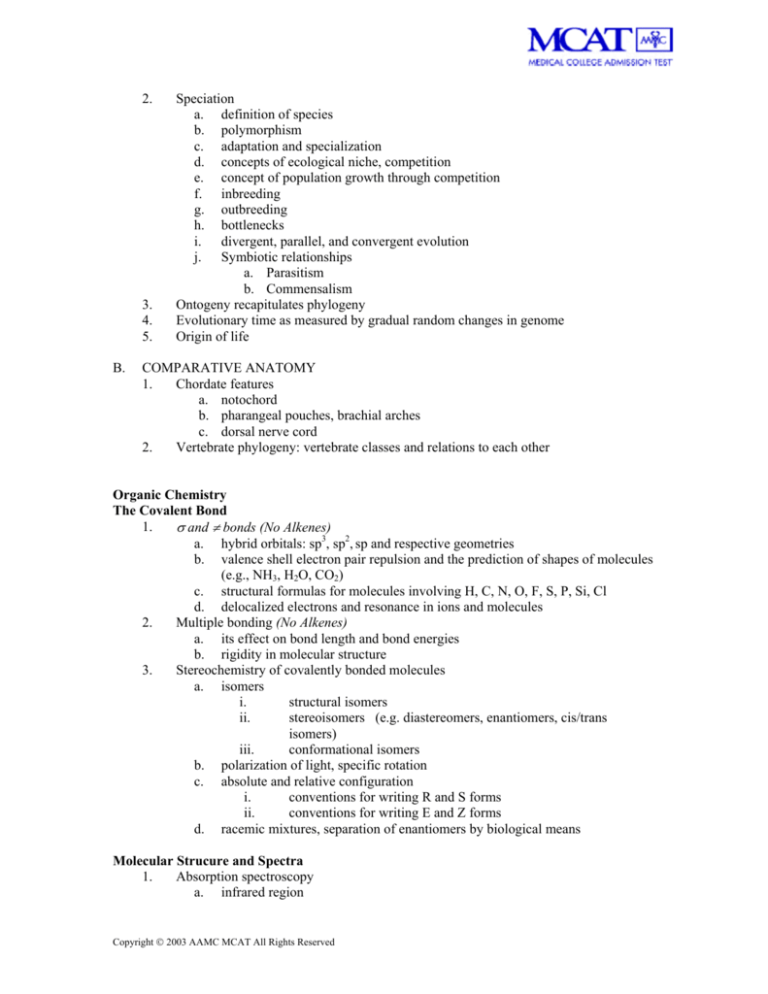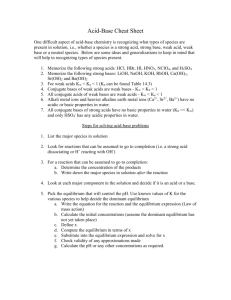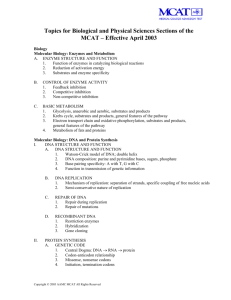
2.
3.
4.
5.
B.
Speciation
a. definition of species
b. polymorphism
c. adaptation and specialization
d. concepts of ecological niche, competition
e. concept of population growth through competition
f. inbreeding
g. outbreeding
h. bottlenecks
i. divergent, parallel, and convergent evolution
j. Symbiotic relationships
a. Parasitism
b. Commensalism
Ontogeny recapitulates phylogeny
Evolutionary time as measured by gradual random changes in genome
Origin of life
COMPARATIVE ANATOMY
1.
Chordate features
a. notochord
b. pharangeal pouches, brachial arches
c. dorsal nerve cord
2.
Vertebrate phylogeny: vertebrate classes and relations to each other
Organic Chemistry
The Covalent Bond
1.
σ and π bonds (No Alkenes)
a. hybrid orbitals: sp3, sp2, sp and respective geometries
b. valence shell electron pair repulsion and the prediction of shapes of molecules
(e.g., NH3, H2O, CO2)
c. structural formulas for molecules involving H, C, N, O, F, S, P, Si, Cl
d. delocalized electrons and resonance in ions and molecules
2.
Multiple bonding (No Alkenes)
a. its effect on bond length and bond energies
b. rigidity in molecular structure
3.
Stereochemistry of covalently bonded molecules
a. isomers
i.
structural isomers
ii.
stereoisomers (e.g. diastereomers, enantiomers, cis/trans
isomers)
iii.
conformational isomers
b. polarization of light, specific rotation
c. absolute and relative configuration
i.
conventions for writing R and S forms
ii.
conventions for writing E and Z forms
d. racemic mixtures, separation of enantiomers by biological means
Molecular Strucure and Spectra
1.
Absorption spectroscopy
a. infrared region
Copyright 2003 AAMC MCAT All Rights Reserved
i.
ii.
2.
3.
intramolecular vibrations and rotations
recognizing common characteristic group absorptions, fingerprint
region
b. visible region
i.
absorption in visible region gives complementary color (e.g.,
carotene)
ii.
effect of structural changes on absorption (e.g., indicators)
c. ultraviolet region (No Alkenes)
i.
π-electron and non-bonding electron transition
ii.
conjugated systems
Mass spectroscopy: m/e ratio, parent peak
NMR spectroscopy
a. protons in a magnetic field; equivalent protons
b. spin-spin splitting
Separations and Purifications
1.
Extraction: distribution of solute between two immiscible solvents
2.
Distillation
3.
Chromatography-basic principles involved in separation process
a. column chromatography
i. gas-liquid chromatography
b. paper chromatography 1, u
c. thin-layer chromotography
4.
Recrystalization; solvent choice from solubility data
Hydrocarbons
A. ALIPHATIC - ALKANES
1.
Description
a. nomenclature
b. physical properties
2.
Important reactions
a. combustion
b. substitution reactions with halogens, etc.
3.
General principles
a. stability of free radicals; chain reaction mechanism; inhibition
b. ring strain in cyclic compounds
c. bicyclic molecules
Oxygen Containing Compounds
A. ALCOHOLS
1.
Description
a. nomenclature
b. physical properties
c. infrared absorption of OH group
Copyright 2003 AAMC MCAT All Rights Reserved
2.
3.
Important reactions
a. substitution reactions: SN1 or SN2, depending on alcohol and derived alkyl
halide
b. oxidation
c. pinacol rearrangement in polyhydroxyalcohols; synthetic uses
d. protection of alcohols
e. reactions with SOCl2 and PBr3
f. preparation of mesylates and tosylates
g. esterification
h. inorganic esters
General principles
a. hydrogen bonding
b. acidity of alcohols compared to other classes of oxygen-containing
compounds
c. effect of chain branching on physical properties
B.
ALDEHYDES AND KETONES
1.
Description
a. nomenclature
b. physical properties
c. infrared absorption of C=O bond
2.
Important reactions
a. nucleophilic addition reactions at C=O bond
i.
acetal, hemiacetal
ii.
imine, enamine
b. reactions at adjacent positions
i.
haloform reactions
ii.
aldol condensation
iii. oxidation
c. 1,3-dicarbonyls: internal H-bonding
d. keto-enol tautomerism
e. organometallic reagents
f. acetoacetic ester syntheses
g. Wolff-Kishner reaction
h. Grignard reagents
3.
General principles
a. effect of substituents on reactivity of C=O; steric hindrance
b. acidity of αH; carbanions
c. α, β-unsaturated carbonyls—resonance structures
C.
CARBOXYLIC ACIDS
1.
Description
a. nomenclature
b. physical properties and solubility
c. infrared absorption
Copyright 2003 AAMC MCAT All Rights Reserved
2.
3.
Important reactions
a. carboxyl group reactions
i.
nucleophilic attack
ii.
reduction
iii. decarboxylation
iv. esterification
b. reactions at 2 position
i.
halogenation
ii.
substitution reactions
General principles
a. H bonding
b. dimerization
c. acidity of the carboxyl group
d. inductive effect of substituents
e. resonance stability of carboxylate anion
D.
ACID DERIVATIVES (ACID CHLORIDES, ANHYDRIDES, AMIDES, ESTERS)
1.
Description
a. nomenclature
b. physical properties
c. infrared absorption
2.
Important reactions
a. preparation of acid derivatives
b. nucleophilic substitution
c. Hoffman degradation of amides; migration of aryl group
d. transesterification
e. hydrolysis of fats and glycerides (saponification)
f. hydrolysis of amides
3.
General principles
a. relative reactivity of acid derivatives
b. steric effects
c. electronic effects
d. strain (e.g., β-lactams)
E.
KETO ACIDS AND ESTERS
1.
Description; nomenclature
2.
Important reactions
a. decarboxylation
b. acetoacetic ester synthesis
3.
General principles
a. acidity of α hydrogen and β-keto ester
b. keto-enol tautomerism
Amines
1.
Description
a. nomenclature
b. stereochemistry and physical properties
c. infrared absorption
Copyright 2003 AAMC MCAT All Rights Reserved
2.
3.
Major reactions
a. amide formation
b. reactions with nitrous acid
c. alkylation
d. Hoffman elimination
General principles
a. basicity
b. stabilization of adjacent carbonium ions (carbocations)
c. effect of substituents on basicity of aromatic amines
Biological Molecules
A. CARBOHYDRATE
1.
Description
a. nomenclature and classification, common names
b. absolute configuration
c. cyclic structure and conformations of hexoses
d. epimers and anomers
2.
Hydrolysis of the glycoside linkage
B.
AMINO ACIDS AND PROTEINS
1.
Description
a. absolute configuration at the α position
b. amino acids as dipolar ions classification
c. classification
i. acidic or basic
ii. hydrophobic or hydrophilic
2.
Reactions
a.
peptide linkage
b.
hydrolysis
3.
General principles
a. 1° structure of proteins
b. 2° structure of proteins
C.
LIPIDS
Description; structure
a. steroids
b. terpenes
c. triacyl glycerols
d. free fatty acids
D.
PHOSPHORUS COMPOUNDS
1.
Description
a. structure of phosphoric acids (anhydrides and esters)
2.
Important reactions
a. Wittig reaction
Copyright 2003 AAMC MCAT All Rights Reserved
General Concepts in Organic Chemistry
A. CLASSIFICATION OF ORGANIC COMPOUNDS ACCORDING TO FUNCTIONAL GROUPS
B.
REACTIONS, REACTION MECHANISMS, AND THE PRINCIPLES INVOLVED (metabolic
enzyme-controlled reactions and pathways are not included in this topic area)
C.
STRUCTURE AND STEREOCHEMISTRY OF ORGANIC COMPOUNDS
D.
IUPAC NOMENCLATURE OF ORGANIC COMPOUNDS
E.
MULTISTEP SYNTHESIS/RETROSYNTHESIS
General Chemistry
Electronic Structure and Periodic Table
A. ELECTRONIC STRUCTURE
1.
Orbital structure of hydrogen atom, principal quantum number n, number of electrons
per orbital
2.
Ground state, excited states
3.
Absorption and emission spectra
4.
Quantum numbers l, m, s, and number of quantum states (electrons) per orbital ]
5.
Common names and geometric shapes for orbitals s, p, d
6.
Conventional notation for electronic structure
7.
Bohr atom
8.
Effective nuclear charge
B.
THE PERIODIC TABLE: CLASSIFICATION OF ELEMENTS INTO GROUPS BY
ELECTRONIC STRUCTURE
1.
Alkali metals; their chemical characteristics
2.
Alkaline earth metals; their chemical characteristics
3.
Halogens; their chemical characteristics
4.
Noble gases; their physical and chemical characteristics
5.
Transition metals
6.
Representative elements
7.
Metals and non-metals
8.
Oxygen group
C.
THE PERIODIC TABLE: VARIATIONS OF CHEMICAL PROPERTIES WITH GROUP
AND ROW
1.
Electronic structure
a. the representative elements
b. the noble gases
c. transition metals
2.
Valence electrons
3.
First and second ionization energy
a. definition
b. prediction from electronic structure for elements in different groups or rows
4.
Electron affinity
a. definition
b. variation with group and row
Copyright 2003 AAMC MCAT All Rights Reserved
5.
6.
Electronegativity
a. definition
b. comparative values for some representative elements and important groups
Electron shells and the sizes of atoms
Bonding
A. THE IONIC BOND (ELECTROSTATIC FORCES BETWEEN IONS)
1.
E = kQ1Q2/d
2.
E = lattice energy
3.
Force attraction = R(n+e)(n-e)/d2
B.
THE COVALENT BOND
1.
σ and π bonds
a. hybrid orbitals: sp3, sp2, sp and respective geometries
b. valence shell electron pair repulsion and the prediction of shapes of molecules
(e.g., NH3, H2O, CO2)
2.
3.
Lewis electron dot formulas
a. resonance structures
b. formal change
c. Lewis acids and bases
Partial ionic character
a. role of electronegativity in determining charge distribution
b. dipole moment
Phases and Phase Equilibria
A. GAS PHASE
1.
Absolute temperature, K scale
2.
Pressure, simple mercury barometer
3.
Molar volume at 0°C and 1 atm = 22.4 mol/L
4.
Ideal gas
a. definition
b. ideal gas law PV=nRT
i. Boyle’s law
ii. Charles’ law
iii. Avogadro’s number
5.
Kinetic molecular theory of gases
6.
Deviation of real-gas behavior from ideal gas law
a. qualitative
b. quantitative (Van der Waals’ equation)
7.
Partial pressure, mole fraction
8.
Dalton’s law relating partial pressure to composition
B.
LIQUID PHASE: INTERMOLECULAR FORCES
1.
Hydrogen bonding
2.
Dipole interactions
3.
Van der Waals’ forces (London dispersion forces)
C.
PHASE EQUILIBRIA
1.
Phase changes and phase diagrams
2.
Freezing point, melting point, boiling point
Copyright 2003 AAMC MCAT All Rights Reserved
3.
4.
5.
6.
Molality
Colligative properties
a. vapor pressure lowering (Raoult’s law)
b. boiling point elevation ((∆Tb = kbm)
c. freezing point depression ((∆Tƒ = –kƒm)
d. osmotic pressure
Colloids
Henry’s Law
Stoichiometry
1.
Molecular weight
2.
Empirical formula versus molecular formula
3.
Metric units commonly used in the context of chemistry
4.
Description of composition by % mass
5.
Mole concept; Avagadro’s number
6.
Definition of density
7.
Oxidation number
a. common oxidizing and reducing agents
b. disproportionation reactions
c. redox titration
8.
Description of reactions by chemical equations
a. conventions for writing chemical equations
b. balancing equations, including oxidation-reduction equations
c. limiting reactants
d. theoretical yields
Thermodynamics and Thermochemistry
A. ENERGY CHANGES IN CHEMICAL REACTIONS-THERMOCHEMISTRY
1.
Thermodynamic system, state function
2.
Conservation of energy
3.
Endothermic/exothermic reactions
a. enthalpy H and standard heats of reaction and formation
b. Hess’ law of heat summation
4.
Bond dissociation energy as related to heats of formation
5.
Measurement of heat changes (calorimetry); heat capacity; specific heat (specific heat
of water = 1 cal/°C)
6.
Entropy as a measure of "disorder"; relative entropy for gas, liquid, and crystal states
7.
Free energy G
8.
Spontaneous reactions and ∆G°
B.
THERMODYNAMICS
1.
Zeroth law: concept of temperature
2.
First law: (∆E = Q – W (conservation of energy)
3.
Equivalence of mechanical, chemical, electrical and thermal energy units
4.
Second law: concept of entropy
5.
Temperature scales, conversion
6.
Heat transfer: conduction, convection, radiation
7.
Specific heat, specific heat of water (1 cal / °C·g)
8.
Heat of fusion, heat of vaporization
9.
PV diagram: work done = area under or enclosed by curve
Copyright 2003 AAMC MCAT All Rights Reserved
10.
Calorimetry
Rate Processes in Chemical Reactions – Kinetics and Equlibrium
1.
Reaction rates
2.
Dependence of reaction rate upon concentration of reactants; rate law
a. rate constant
b. reaction order
3.
Rate determining step
5.
Kinetic control versus thermodynamic control of a reaction
6.
Catalysts; the special case of enzyme catalysis
7.
Equilibrium in reversible chemical reactions
a. Law of Mass Action
b. the equilibrium constant
c. application of LeChatelier’s principle
8.
Relationship of the equilibrium constant and ∆G°
Solution Chemistry
A. IONS IN SOLUTION
1.
Anion, cation; common names, formulas and charges for familiar ions (e.g., NH4+
ammonium, PO43– phosphate, SO42– sulfate)
2.
Hydration, the hydronium ion
B.
SOLUBILITY
1.
Units of concentration (e.g., molarity)
2.
Solubility product constant; the equilibrium expression
3.
Common-ion effect; its use in laboratory separations
a. complex ion formation ]
b. complex ions and solubility
c. solubility and pH
Acids/Bases
A. ACID/BASE EQUILIBRIA
1.
Brønsted definition of acid, base
2.
Ionization of water
a. Kw, its approximate value (Kw = [H+][OH–] = 10–14 at STP)
b. definition of pH; pH of pure water
3.
Conjugate acids and bases (e.g., amino acids)
4.
Strong acids and bases (common examples, e.g., nitric, sulfuric)
5.
Weak acids and bases (common examples, e.g. acetic, benzoic)
a. dissociation of weak acids and bases with or without added salt
b. hydrolysis of salts of weak acids or bases
c. calculation of pH of solutions of salts of weak acids or bases
6.
Equilibrium constants Ka and Kb: pKa, pKb
7.
Buffers
a. definition and concepts (common buffer systems)
b. influence on titration curves
B.
TITRATION
1.
Indicators
2.
Neutralization
3.
Interpretation of titration curves
Copyright 2003 AAMC MCAT All Rights Reserved
4.
Redox titration
Electrochemistry
1.
Electrolytic cell
a. electrolysis
b. anode, cathode
c. electrolyte
d. Faraday’s law relating amount of elements deposited (or gas liberated) at an
electrode to current
e. electron flow; oxidation, and reduction at the electrodes
2.
Galvanic or voltaic cell
a. half reactions
b. reduction potentials; cell potential
c. direction of electron flow
Physics
Translational Motion
1.
Units and dimensions
2.
Vectors, components
3.
Vector addition
4.
Speed, velocity (average and instantaneous)
5.
Acceleration
6.
Freely falling bodies
Force and Motion, Gravitation
1.
Center of mass
2.
Newton’s first law, inertia
3.
Newton’s second law (F = ma)
4.
Newton’s third law, forces equal and opposite
5.
Concept of a field
6.
Law of gravitation (F = KGm1m2/r2)
7.
Uniform circular motion
8.
Centripetal acceleration (F=mv2/r)
9.
Weight
10. Friction, static and kinetic
11. Motion on an inclined plane
12. Analysis of pulley systems
13. Force
Equilibrium and Momentum
A. EQUILIBRIUM
1.
2.
3.
4.
5.
6.
7.
Concept of force, units
Translational equilibrium (ΣFi = 0)
Rotational equilibrium (ΣτI = 0)
Analysis of forces acting on an object
Newton’s first law, inertia
Torques, lever arms
Weightlessness
Copyright 2003 AAMC MCAT All Rights Reserved







